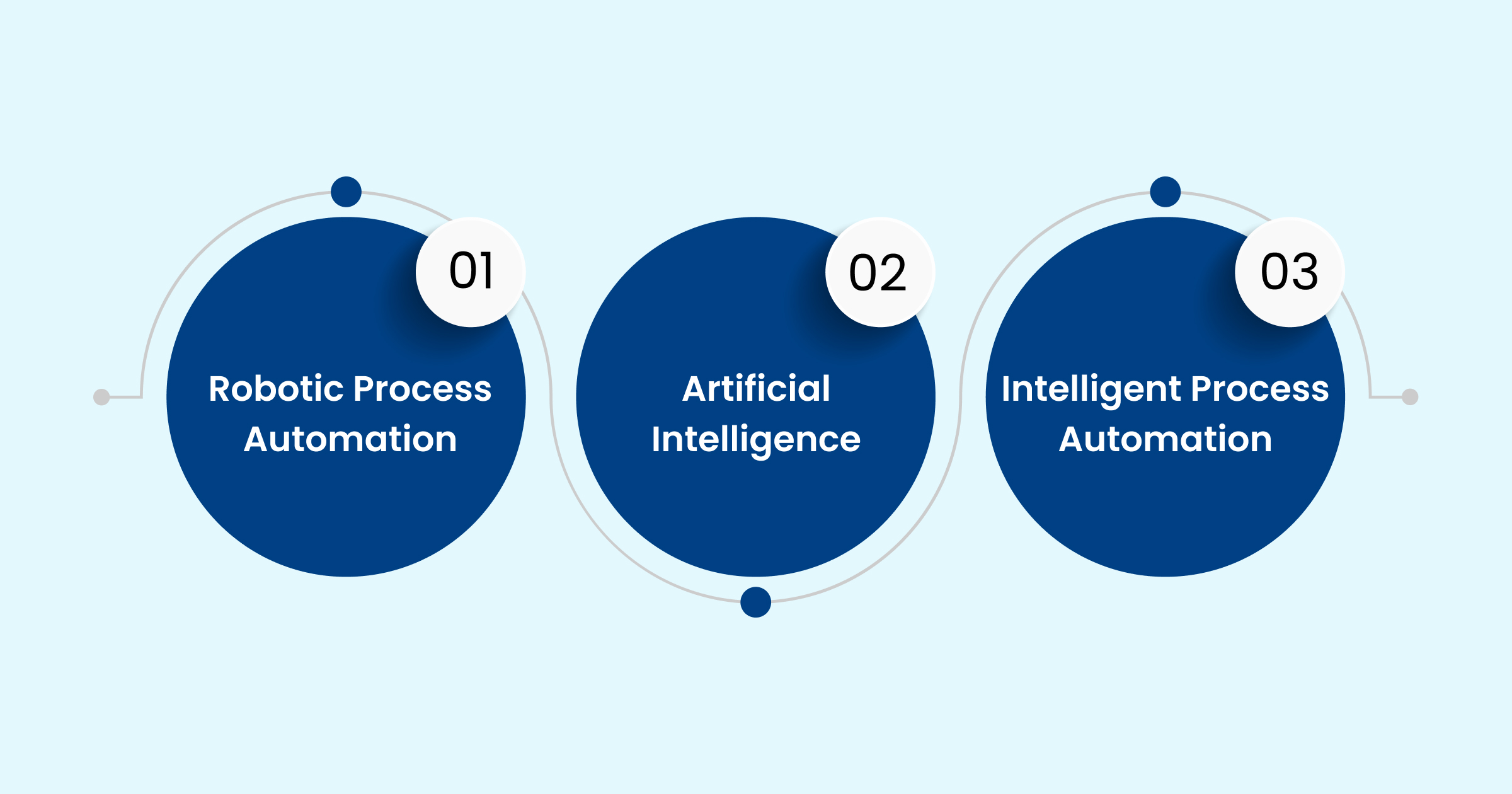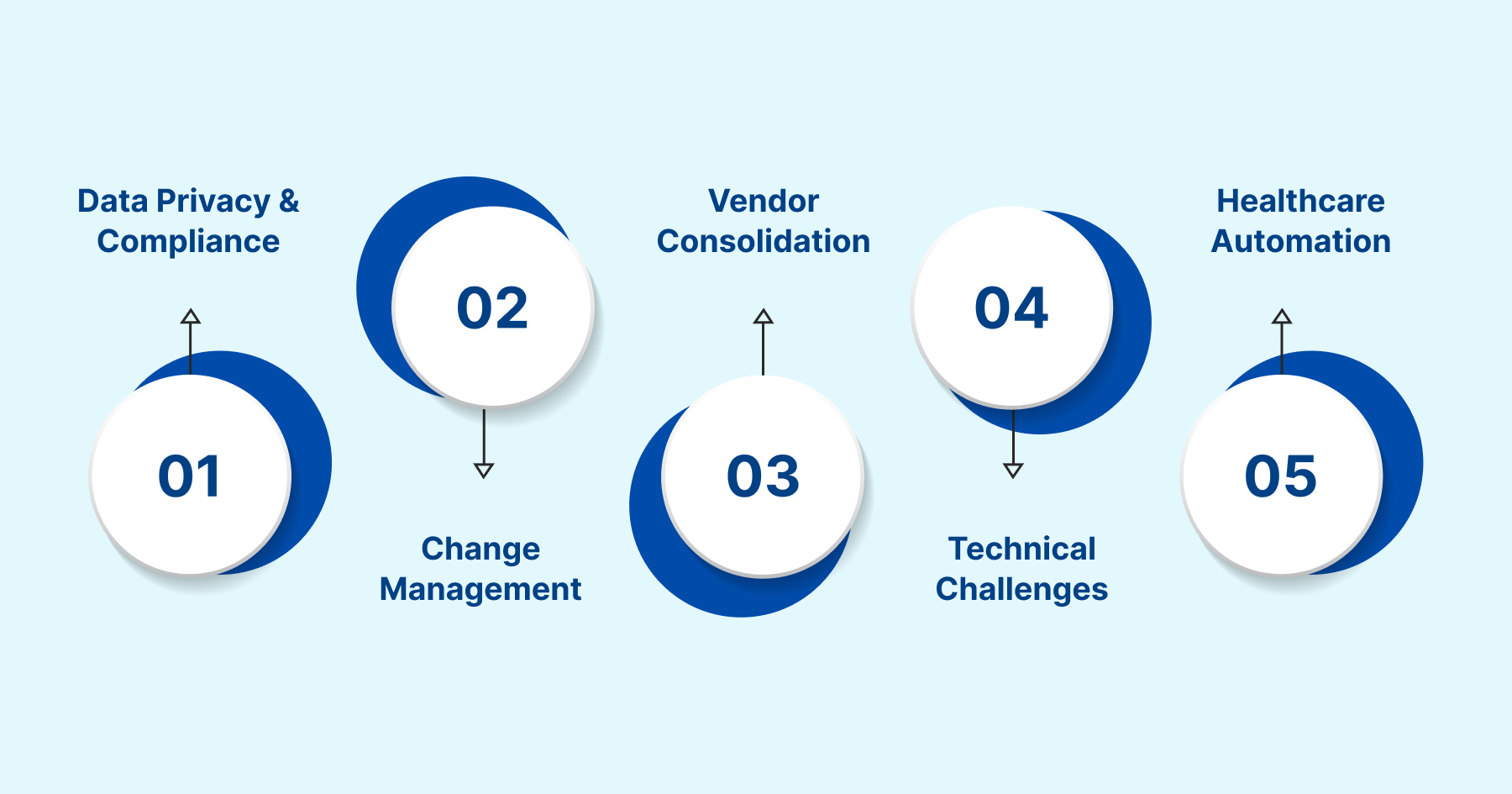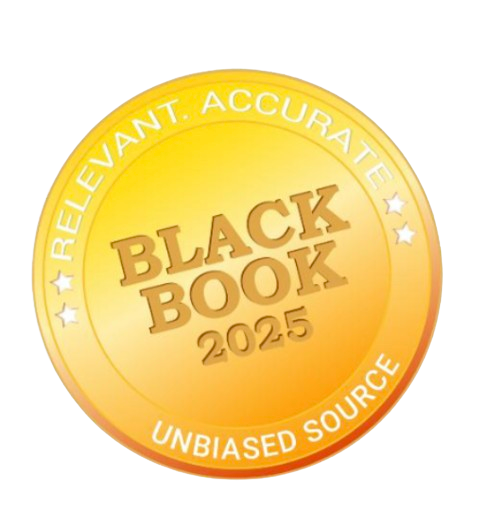.webp)
Robotic Process Automation and AI in Healthcare Operations

Ever wondered how much U.S. hospitals spend on administrative costs each year? Medicare Cost Reports from 5,639 hospitals show expenses reached $166.1 billion, or 17% of total spending, creating heavier workloads and tighter margins for revenue cycle managers, coders, and compliance officers.
To address these pressures, healthcare organizations are increasingly turning to automation. The robotic process automation (RPA) market in healthcare is expected to reach $6.05 billion by 2032. This growth reflects the sector’s focus on reducing errors, streamlining workflows, and ensuring regulatory compliance.
In this blog, you’ll discover how AI and robotic process automation streamline audits, optimize the revenue cycle, strengthen compliance, and modernize back-office operations for healthcare organizations.
TL;DR (Key Takeaway)
- Rising administrative workloads and compliance demands are pushing healthcare organizations toward automation.
- RPA automates rules-based tasks like coding, claims, and audit routing, while AI adds cognitive functions like NLP, ML, and predictive analytics.
- Combined, they form Intelligent Process Automation (IPA), delivering measurable outcomes in claims, revenue cycle, audits, and hospital operations.
- Adoption challenges include data privacy, change management, fragmented vendors, technical integration, and need for healthcare-specific platforms.
- Purpose-built solutions like RapidClaims enable compliance-ready automation, improving coding accuracy, denial management, audit readiness, and ROI.
Table of Contents:
- What Are Robotic Process Automation and AI?
- Real-World Use Cases: From Audits to Revenue Cycle
- How to Integrate AI with RPA in Healthcare Automation?
- Challenges and Best Practices for RPA and AI Adoption
- Conclusion
- Frequently Asked Questions (FAQs)
What Are Robotic Process Automation and AI?

Robotic Process Automation (RPA) and Artificial Intelligence (AI) are transforming healthcare operations by automating structured and unstructured tasks. RPA focuses on speed and accuracy for rule-based workflows, while AI adds cognitive intelligence to interpret data, predict risks, and support clinical and financial decision-making. Together, they form Intelligent Process Automation (IPA), enabling healthcare organizations to streamline revenue cycles, strengthen compliance, and improve operational efficiency.
1. Robotic Process Automation (RPA)
RPA handles repetitive, rule-driven tasks without human intervention, ensuring operational consistency and freeing staff for higher-value work.
- Executes workflows across digital systems with speed and precision
- Common tasks: claims submission, coding validation, audit data collection
- Reduces manual errors in administrative processes
Example: Automating insurance claims data entry minimizes keystroke errors, speeds up reimbursements, and allows staff to focus on complex exceptions.
2. Artificial Intelligence (AI)
AI analyzes complex patterns in structured and unstructured data to uncover insights that are difficult or time-consuming for humans to detect.
- Uses natural language processing (NLP), machine learning (ML), and predictive analytics
- Interprets physician notes, scanned reports, and payer guidelines
- Identifies coding errors, predicts claim denials, and improves decision support
Example: AI models trained on denial history can flag high-risk claims before submission, reducing revenue leakage and rework.
3. Intelligent Process Automation
IPA combines RPA’s workflow consistency and speed with AI’s intelligence for adaptive, end-to-end process automation.
- Automates dynamic workflows that adjust to payer rules, regulatory updates, and real-time data
- Enhances compliance with transparent audit trails and automated checks
- Routes are only exceptions to human coders, maximizing efficiency
Example: IPA can auto-generate compliant codes, apply payer-specific edits, and forward exceptions for review, resulting in a 70% reduction in denials.
Now let’s explore how “robotic process automation and AI” are reshaping real-world healthcare workflows and audits.
Real-World Use Cases: From Audits to Revenue Cycle
In practice, the convergence of AI and RPA is already delivering powerful outcomes in healthcare:
- Claims and Billing Automation: Omega Healthcare Management, which supports over 350 healthcare entities, has deployed UiPath’s AI-powered Document Understanding. Since implementation, they’ve automated 60–70% of clients’ tasks, saving 15,000 employee hours per month, cutting documentation time by 40%, halving turnaround time, achieving 99.5% accuracy, and delivering a 30% ROI.
- Revenue Cycle Transformation: As noted in August 2025, combining RPA with AI tools like machine learning and NLP is shifting payer/provider operations from reactive to predictive, enabling proactive denial management and optimized workflows.
- Audit and Revenue Accuracy: RPA handles gathering and routing audit data, while AI pre-checks coding and billing alignment. This hybrid reduces claims errors and bolsters audit compliance efficiently.
- Robotic support in hospitals: Robots like Moxi are deployed across 30 U.S. hospitals to automate supply delivery and medication transport, freeing nurses for patient care, while also informing the opportunity spectrum for AI-RPA integration in operations.
RapidClaims uses AI-powered automation to streamline coding, clinical documentation, denial prevention, and recovery across the healthcare revenue cycle. Its AI-driven modules, including RapidCode, RapidScrub, and RapidRecovery, handle repetitive tasks while providing intelligent insights for complex decision-making. From autonomous ICD-10, CPT, and E/M coding to predictive denial prevention and real-time HCC and RAF optimization, RapidClaims reduces manual work, speeds up claim processing, and ensures compliance with clear audit trails.
Also Read: 2025 Telehealth Updates: Key E/M Code Changes & Medicare Policies
How to Integrate AI with RPA in Healthcare Automation?

Healthcare professionals, including coders, auditors, and revenue cycle managers, can use this step-by-step guide to implement RPA and AI together efficiently. Following these best practices helps streamline workflows, improve accuracy, and enhance compliance across healthcare operations.
1. Identify High-Impact Processes for Automation
Focus on tasks that are repetitive, time-consuming, and prone to errors. Key areas include:
- Claims submission and denial tracking
- Coding validation and error detection
- Audit documentation collection
- Revenue reconciliation processes
Starting with high-impact tasks ensures quick wins and measurable efficiency gains.
2. Pair RPA with AI for Cognitive Tasks
RPA orchestrates workflows while AI handles data-driven, cognitive tasks:
- Extract data from EHRs, PDFs, and structured or unstructured sources using OCR and NLP
- Predict claim denials or coding discrepancies with machine learning
- Automate routine corrections or flag exceptions for human review
Combining RPA and AI enables both speed and intelligence in processing complex healthcare operations.
3. Implement a Human-in-the-loop Design
Maintain oversight and compliance by combining automation with human judgment:
- Coders and auditors verify AI-extracted information
- Configurable automations ensure transparency and regulatory compliance
- Feedback loops refine algorithms and improve accuracy over time
This approach strikes a balance between efficiency and quality control.
4. Track ROI, Accuracy, and Compliance Metrics
Measure the effectiveness of AI and RPA implementations:
- Time saved, such as hours reclaimed or documents processed
- Accuracy improvements, aiming for 99%+
- Cost savings and return on investment from automation initiatives
Tracking metrics demonstrates value and supports continuous improvement.
5. Scale in phases
Expand automation gradually to minimize risk and maximize efficiency:
- Start with a pilot in one domain, such as claims processing
- Once validated, extend to other areas like scheduling, patient onboarding, or audit preparation
Phased implementation ensures smooth adoption and sustainable results.
By following these steps, healthcare organizations can integrate RPA and AI efficiently while ensuring accuracy, compliance, and measurable impact. RapidClaims brings this blueprint to life with end-to-end healthcare revenue-cycle automation. It delivers a 98% clean-claim rate, 170% coder productivity lift, and 40% denial reduction, helping providers cut costs, recover revenue, and succeed in both FFS and VBC models.
Challenges and Best Practices for RPA and AI Adoption

Implementing RPA and AI in healthcare can transform workflows, improve accuracy, and enhance compliance. However, organizations often face hurdles such as regulatory constraints, technical complexity, and staff resistance.
Below are a few key challenges and best practices to consider for successful adoption:
1. Data Privacy & Compliance
Healthcare organizations operate under strict HIPAA and regulatory requirements. Any mishandling of PHI during RPA automation or AI processing can lead to data breaches, financial penalties, and reputational damage. RPA logs and AI models must be fully auditable, secure, and compliant with internal and external regulations.
- Best Practice: Select healthcare-focused automation platforms that embed compliance features, including encrypted data storage, secure audit trails, and role-based access. Regularly validate AI models to ensure they process sensitive data safely and provide full traceability for audits.
2. Change Management
Staff may fear job displacement due to automation, leading to resistance or disengagement. Without buy-in, adoption stalls, and efficiency gains are limited.
- Best Practice: Communicate clearly how AI and RPA enhance roles rather than replace them, shifting staff focus to high-value decision-making and exception handling. Provide structured training programs, workshops, and pilot initiatives to demonstrate the benefits and build confidence among coders, auditors, and revenue cycle staff.
3. Vendor Consolidation
The RPA and AI vendor landscape is fragmented, with varying levels of security, interoperability, and healthcare-specific capabilities. Selecting incompatible platforms can create integration headaches and compliance risks.
- Best Practice: Choose enterprise-grade platforms that support healthcare standards and offer seamless integration. Features like UiPath’s AI Trust Layer ensure secure model deployment, while vendor consolidation reduces complexity, simplifies maintenance, and improves scalability.
4. Technical Challenges
Combining AI and RPA requires careful coordination across IT, compliance, coding teams, and external vendors. Integration involves workflow orchestration, data normalization, model training, and ongoing monitoring, which can strain resources.
- Best Practice: Involve cross-functional teams from the outset to define objectives, ensure transparent logging and audit trails, and establish continuous feedback loops. Maintain dedicated monitoring and maintenance protocols to ensure ongoing performance, accuracy, and regulatory adherence.
5. Purpose-Built Healthcare Automation
Generic automation tools often plateau, missing the regulatory depth and coding precision that healthcare requires. Manual, error-prone workflows create 20-40% revenue leakage, while payer policy shifts drive year-over-year denial increases.
- Best Practice: Adopt platforms like RapidClaims, explicitly built for healthcare revenue cycle needs. With SMART-on-FHIR integration and continuous payer-driven learning, RapidClaims ensures compliance while scaling automation. Its modules deliver measurable results: 96% audited coding accuracy with RapidCode, 25% RAF accuracy improvement with RapidCDI, and 70% fewer claim denials with RapidScrub. These outcomes strengthen audit readiness, protect margins, and reduce repetitive documentation burdens.
When addressed thoughtfully, these practices enable AI-powered RPA to drive measurable improvements in productivity, compliance, audit readiness, and operational efficiency, building trust among staff and stakeholders.
Conclusion
Manual coding and repetitive administrative tasks slow revenue cycles, increase errors, and create compliance risks. RPA and AI work together to automate workflows, validate codes, predict denials, and enable human-in-the-loop review, allowing healthcare teams to focus on decision-making while improving accuracy and efficiency.
Healthcare organizations can achieve these benefits with RapidClaims. Its AI-powered solutions streamline coding, audits, and revenue cycle processes, ensuring faster claim processing, higher accuracy, and compliance readiness. With secure, auditable workflows, RapidClaims helps organizations manage complex processes confidently.
Take the next step in optimizing your healthcare revenue cycle. Request a Free Demo and see how RapidClaims’ AI-powered RPA can transform your healthcare operations and make your team more efficient, accurate, and audit-ready.
Frequently Asked Questions (FAQs)
1. How can I ensure AI and RPA comply with healthcare regulations?
A. Choose platforms designed for healthcare that include encrypted data storage, secure access controls, and complete audit trails. Regularly review compliance with HIPAA and other regulations, and train staff on proper handling of PHI to prevent breaches and maintain accountability.
2. How can I measure ROI for AI and RPA in my organization?
A. Track metrics such as claim processing time reduction, error rate improvements, and administrative cost savings. Also consider qualitative benefits, including improved staff efficiency and faster patient service. Compare these results to baseline operations before implementation to quantify the impact accurately.
3. How do I address staff concerns about job loss from automation?
A. Clearly communicate that AI and RPA handle repetitive tasks, allowing staff to focus on complex and value-added work. Provide structured training and upskilling programs to help employees adapt, and involve them in pilot projects to build confidence and buy-in.
4. How can I integrate AI and RPA with existing EHR systems?
A. Ensure your chosen platforms are compatible with your EHR and support APIs or middleware for seamless integration. Automate tasks such as data entry, coding, and billing while maintaining data integrity, and coordinate with IT and EHR vendors to prevent workflow disruptions.
5. How can I maintain human oversight with AI and RPA?
A. Implement a human-in-the-loop model where staff review AI outputs, particularly for complex or ambiguous cases. Establish audit processes and feedback loops to continuously refine automation accuracy, ensuring that AI and RPA enhance decision-making without replacing professional judgment.
%201.png)







